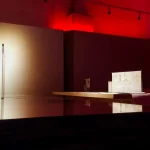Concrete Islands Exhibition Paris 2011, Analix Forever, Architecture, Design, Image
Concrete Islands Exhibition, Paris
Architecture in France : Analix Forever Show
11 Apr 2011
Concrete Islands Paris Exhibition
A voir à Paris, e-architect was there.
Saturday 9th April, Paris – Analix Forever, Geneva, open their first Paris show called, The concrete Islands, an exhibition dedicated to monumental concrete edifices of the last century.
Elias Redstone, the curater, selected the images (photographs and videos) of five artists, who explored “the lives” of these monumental buildings in various ways.
At the beginning many of these constructions were symbols of wealth and worldliness, however, today they stand forgotten and decaying, slowly returning to nature.
Why would one want to look at something, which is so inherently “passé”? Well, because in this case, the images are absolutely fascinating and very thought-provoking. Let’s hope this is the first of many.
25 Mar 2011
Concrete Islands Exhibition Paris
9 – 17 Apr 2011
Opening Times: Open daily 11am-7pm
Curated by Elias Redstone for Analix Forever
Andreas Angelidakis (Greece)
Iwan Baan (The Netherlands)
Frédéric Chaubin (France)
mounir fatmi (Morocco)
Niklas Goldbach (Germany)
Analix Forever’s first show in Paris
Venue: Six Elzévir, 6 rue Elzévir, 75003 Paris
Morning Routine, Le Corbusier, Palace of the Assembly, Chandigarh, 2010:
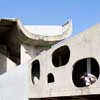
photo © Iwan Baan and Analix Forever
Concrete Islands is a group exhibition of photography and video exploring contemporary experiences of utopian architectural projects. For many architects modernism was a physical manifestation of human progress and, as architectural historian Colin Rowe wrote in The Architecture of Good Intentions, “The architect could stipulate an intrinsic connection between the form of his buildings and the condition of society.” The works in Concrete Islands, by a selection of international contemporary artists, document, celebrate and critique architectural projects designed with inherent social and political values that now exist in various stages of inhabitation, dereliction and destruction.
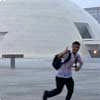
picture from Elias Redstone / Analix Forever
The influence of architects to control space and determine its social structures alters over time. The artists each provoke an emotional response from the architecture as they find it now, adding their own narrative and interpretation, and exposing new relationships between the architecture, society and nature. As the title Concrete Islands suggests, what we find is architecture that exists in some form of isolation – whether that is geographical, social or ideological.
Andreas Angelidakis often introduces fiction and fantasy into his work to reveal truths about architecture. The film ‘Troll’ tells the story of a modernist, low-income apartment building in Athens that wants to be a mountain. The building, called Chara (‘Joy’) was built by Spanos and Papailiopoulos architects in 1960, taking up an entire city block with a network of interior gardens. Over time it has felt the effects of Athens’ extensive urbanization and deteriorating economy. Angelidakis takes a leap of imagination, suggesting that the accumulation of plants and soil in this garden-housing overtakes the architecture and Chara wants to become a mountain and leave the city altogether. Angelidakis suggests that ruins are just buildings on their way to becoming nature.
Iwan Baan’s work is characterized by his portrayal of people in architecture, revealing the context, society and environment around architecture. He has photographed two of the most ambitious urban projects of the 20th century, Chandigarh and Brasília, both conceived out of political agendas and presenting the future as conceived by its creators. Baan’s images show real life taking place in these two invented cities that have adapted to everyday social rituals and basic needs. Oscar Niemeyer’s Museu Nacional provides little protection from the elements within Brasília’s urban plan laid out by Lúcio Costa. A young man remains enthusiastic as he is drenched in the rain, while small crowds find shelter under the building’s entrance ramps. In Le Corbusier’s Palace of the Assembly in Chandigarh two men are viewed bathing and dressing themselves through the perforated concrete façade. Whether they live or work in the building is ambiguous, but here they have found a space suitable to conduct their morning routine.
Over the course of many journeys to Eastern Europe and Asia between 2003 and 2010, Frédéric Chaubin has been searching for and photographing atypical examples of architecture dating from the late Soviet era. Largely located in regions on the periphery of the former USSR, such buildings are defined by a utopian formal language uncharacteristic of the standard paradigms of Soviet state architecture. The buildings express the dreams of architects that were educated within a strict Soviet system yet, perhaps as a paradox, managed to achieve immense creative freedom in their work. According to Chaubin, this diversity of architectural style during the late 1970s is an expression of the demise in Soviet totalitarian homogeneity. His deliberate enhancement of the dramatic dimension to these buildings pays homage to the imagination of those non-conformist architects and underscores the fictional dimension of history.
Le Val-Fourré was built in the 1960s in the Parisian banlieue of Mantes-la-Jolie as a large scale, optimistic project to meet the increased demand for homes in the city. Densely populated, under resourced and poorly integrated with public transport, the residential project has become a place of escalating frustrations and civil unrest since the 1990s. During a residency at Le Chaplin in Mantes-la-Jolie, mounir fatmi made several films documenting the gradual demolition of Le Val Fourré. ‘Architecture Now! Etat des lieux #1’ focuses on an individual apartment as it is torn down by a bulldozer. The men demolishing the building are as absent from view as its former residents, leaving the social implications of such an act to the imagination. As the architecture is slowly destroyed, nature is revealed. ‘Gan Eden’, a film by Niklas Goldbach, also inverts the relationship between architecture and nature. It was filmed in 2005 in the remains of the Dutch pavilion designed by MVRDV for the World Expo 2000 in Hanover, Germany. The pavilion was intended as a multi-level park but was left to decay when the Expo closed. Goldbach’s film sees two men cruising in the decaying pavilion as an act of re-appropriation. In a text in the accompanying catalogue, the architects celebrate the creation of a new ruin in this transition from utopia to distopia. Overcome by nature, the pavilion became the park it had always aspired to be.
Elias Redstone
Concrete Islands Exhibition Paris Artists
About the artists
Andreas Angelidakis runs an experimental practice in Athens, Greece, that is involved in building, designing and speculating the contemporary ecosystem of screens and landscapes. His medium is habitation, of buildings, clouds, spaces, furniture, videos, online communities or exhibition spaces, and operates at the intersection of systems: Art and Architecture, Virtual and Real, Building and Nature, Ruin and Construction. His work has been exhibited at the Venice Architecture Biennale, Sao Paolo Biennial, ExperimentaDesign in Lisbon, and Espace Culturel Louis Vuitton and Jeu de Paume in Paris. www.angelidakis.com
Dutch photographer Iwan Baan is known primarily for images that narrate the life and interactions that occur within architecture. Born in 1975, Iwan grew up outside Amsterdam and studied at the Royal Academy of Art in The Hague. He collaborates with many architects including Rem Koolhaas, Herzog & de Meuron, SANAA, Frank Gehry, Toyo Ito and Zaha Hadid. His photography has been featured in exhibitions at MoMA in New York and the Architectural Association in London. He has also conducted documentary projects across Africa, Asia and Latin America. www.iwan.com
Frédéric Chaubin, born in Cambodia, is an artist, writer and editor-in-chief of Citizen K magazine for the last fifteen years. His photography considers architecture as an expression of its historical, cultural and anthropological condition. In 2003 he began a seven year project photographing unusual structures within the former USSR. ‘Cosmic Communist Constructions Photographed’ was published by Taschen in 2011. Solo exhibitions include ZKM Museum of Contemporary Art, Karlsruhe, and the Storefront for Art and Architecture, New York. www.fredericchaubin.com
mounir fatmi was born in Tangier, Morocco in 1970. His practice involves constructing visual spaces and linguistic games that aim to free the viewer from their preconceptions. His videos, installations, drawings, paintings and sculptures bring to light our doubts, fears and desires. His work was featured in Paradise Now! Essential French Avant-Garde Cinema 1890- 2008 at the Tate Modern in London and Traces du Sacré at the Centre Georges Pompidou in Paris. www.mounirfatmi.com
German artist Niklas Goldbach creates video, sculpture and photographic works that focus on dystopic aspects of architecture. Gan Eden is the second in a series of videos about utopia in urban culture. His films have been screened at the International Architecture Film Festival Rotterdam, Temporary Kunsthalle Berlin and the Barbican, London. He was an artist in residence at the Palais de Tokyo, Paris, in 2007/08. www.niklasgoldbach.de
Concrete Islands Exhibition Paris image / information from Elias Redstone / Analix Forever
Location: Six Elzévir, 6 rue Elzévir, 75003 Paris, France
Paris Architecture
Contemporary Architecture in Paris
Paris Architecture Design – chronological list
Paris Architecture – Selection
The Phare
Morphosis, Architects
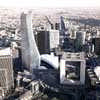
image from architect
The Phare Paris
Atelier Christian de Portzamparc
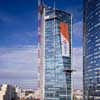
image from architect
Société Générale tower
C42 – Citroën display building
Manuelle Gautrand
C42 Citroen Building
Atelier Jean Nouvel
Tour Signal
Architectural Exhibitions – Selection
Design Living World Exhibition
Comments / photos for the Concrete Islands Exhibition Paris page welcome

